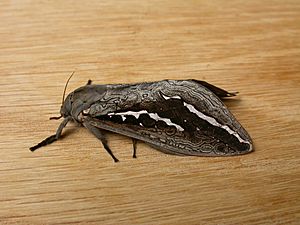Bardee facts for kids
Quick facts for kids Bardee |
|
|---|---|
 |
|
| Scientific classification | |
| Kingdom: | |
| Phylum: | |
| Class: | |
| Order: | |
| Family: |
Hepialidae
|
| Genus: |
Trictena
|
| Species: |
T. atripalpis
|
| Binomial name | |
| Trictena atripalpis (Walker, 1856)
|
|
| Synonyms | |
|
|
The Trictena atripalpis, also known as the rain moth or bardee grub, is a very large moth. It belongs to the Hepialidae family. You can find this moth across the southern half of Australia.
Where Rain Moths Live
The rain moth lives in many parts of southern Australia. They prefer woodland areas. You will often find them near creeks and gullies. They especially like places where eucalyptus trees grow.
The Bardee Grub (Caterpillar)
The caterpillar stage of the rain moth is very popular. Fishermen often use these caterpillars as bait. This is why they are commonly called "bardee", "bardi", "badee", or "bargi grub".
The name "bardee grub" is also used for other insect larvae. These include the larvae of the beetle Bardistus cibarius and some Cerambycid species. It also refers to other moth caterpillars that live in the ground or bore into wood.
Rain moth caterpillars live in tunnels underground. They eat plants, making them herbivores. Their favorite foods are Casuarina pauper and different types of Eucalyptus trees. A common food source is the Eucalyptus camaldulensis tree.
The Adult Rain Moth
The adult moths are called "rain moths" for a good reason. They often appear after it rains, usually in autumn. When they emerge, you can sometimes see their empty pupal cases sticking out of the ground.
These moths can be quite large. Male moths can have a wingspan of up to 120 millimeters (about 4.7 inches). Females are even bigger, with wingspans up to 170 millimeters (about 6.7 inches). That's almost as big as a small bat!
The moths have fawn wings (a light brownish-yellow color). Each front wing has two shiny silver markings. Because of their size, owls sometimes hunt and eat them.
Female rain moths are amazing egg-layers. They can produce a huge number of eggs, sometimes up to 40,000! They scatter these tiny eggs while flying. You can usually see adult rain moths flying from April to June.

